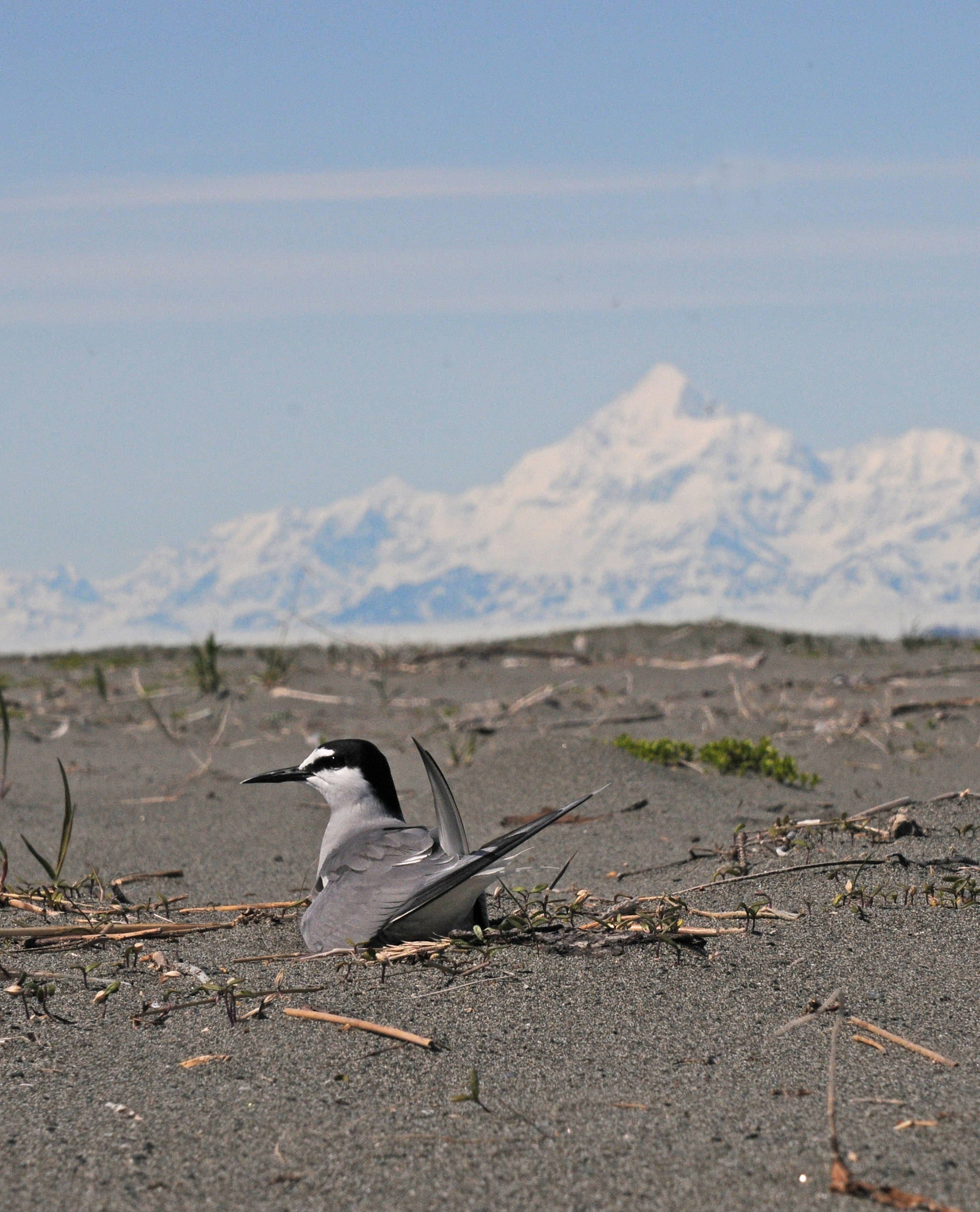In early June, I had the privilege of participating in the Yakutat Tern Festival. This gave me the opportunity of visiting an area of Southeast that I’d never explored before (as well as meeting some new and interesting folks). There were only two familiar faces, one of which belonged to Linda Rosenthal; she was there as a visiting musical artist, and her violin wizardry kindly provided the introduction to my seminar!
From my little explorations, several natural history items stand out. Brown bears lived up to their reputation of being very common. In just over four days, I saw nine of them, at least one every day. Some were grazing in the meadows, including three young cubs whose mother was not in evidence but must have been somewhere nearby.
We saw several Caspian terns—huge (for a tern), with a big red bill and a raucous voice. Much more common are two smaller terns: the Arctic tern, which also nests in Juneau, and the Aleutian tern. Yakutat is reputed to be the southernmost nesting colony of the Aleutian species on mainland North America; this species also nests along the Aleutian chain and the coasts of western Alaska and eastern Russia.
The small terns look quite similar to each other, but the Aleutian tern has a distinguishing white forehead mark on its black cap; it also has a slightly shorter tail and a darker back, as well as a call that differs from that of the Arctic tern. Both species feed on small fishes and sometimes shrimp-like invertebrates. Both species are long-distance migrants: our familiar Arctic terns go all the way to Antarctica after the summer nesting season here, so they enjoy perpetual summer (when it is winter here, it’s summer down there, of course). The Aleutian tern migrates from here down the coast of eastern Asia to the seas around Indonesia. I wonder what they eat down there: tropical seas are usually said to be less productive than high-latitude waters, which is why our humpback whales come up here from their winter quarters in Hawaii.
Because they usually nest on the ground on sparsely vegetated sandflats (Arctics reportedly in slightly more open areas than Aleutians), both species are too easily subject to disturbances that ruin their nesting attempts — humans and their dogs can have devastating effects on a whole colony of terns. Of course, wily predators such as ravens are eager eaters of eggs; coyotes (and foxes is some areas) like both eggs and adults if they can get them. Sometimes a whole colony deserts a traditional nesting area and goes elsewhere, and sometimes the whole group just gets wiped out. So little is currently known about Aleutian terns that the loss or reduction of known colonies raises concern about the population status of the species, so studies are now underway in Alaska to discover if the birds have established new colonies to replace the lost ones.
We saw several parasitic jaegers (in German, jaeger means “hunter”), harassing gulls that were actively fishing. Jaegers are kleptoparasites, stealing prey from other birds that catch prey for themselves. One jaeger dove repeatedly at a small gull that held a just-caught fish, following every evasive action of the gull, until the gull finally gave up and the jaeger got the fish. Parasitic jaegers nest on the tundra up north, where they are quite capable of catching their own prey; their kleptoparasitic habits are exercised chiefly on migration and in winter.
In among the several kinds of gulls were black-legged kittiwakes, which resemble gulls but technically are not gulls. I seldom see them in Juneau, although they nest in Glacier Bay. Kittiwakes are typically cliff-nesters, but the Yakutat forelands do not offer many cliffs, so these individuals may nest across the bay near the glacier or perhaps they are non-breeders.
Other sightings that provoked thought include the observation of large differences among beaches in the animal remains that were left by a receding tide. One large sandy beach yielded shells and claws of Dungeness crabs and the shells of razor clams. Another had some mussels and clam shells (more like many Juneau beaches). And one had nothing at all except one long-dead sea star—that seemed very odd.
On one large sandflat there were moonworts growing among other sparsely distributed plants. Moonworts are rather peculiar fern relatives about which relatively little is known. Recent research has found two new species of moonwort in Southeast (I was told that Yakutat is one place where they live), but for those of us who are not specialists, they look very much alike.
We found a small colony of cliff swallows, which stick their gourd-shaped mud nests to rocky cliffs or the sides of buildings and I-beams under bridges. From almost every nest opening peered the face of an adult bird, while other adults flew back and forth, sometimes delivering a tasty morsel to the nest occupant. We inferred that one adult was incubating eggs or brooding very small chicks while the other adult of the pair went hunting. Male and female cliff swallows equally share the parental tasks of incubation and feeding chicks.
Barn swallows were tending their nests too, and every morning brought a chorus of bird song from several species of sparrow and warbler, especially in the alder and willow thickets. Worth getting up for!
• Mary F. Willson is a retired professor of ecology.

